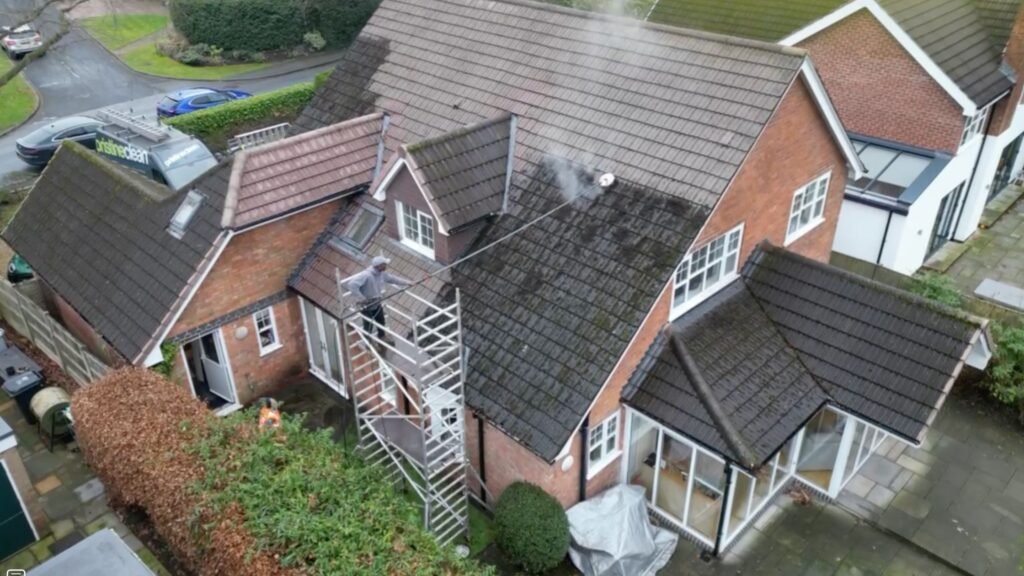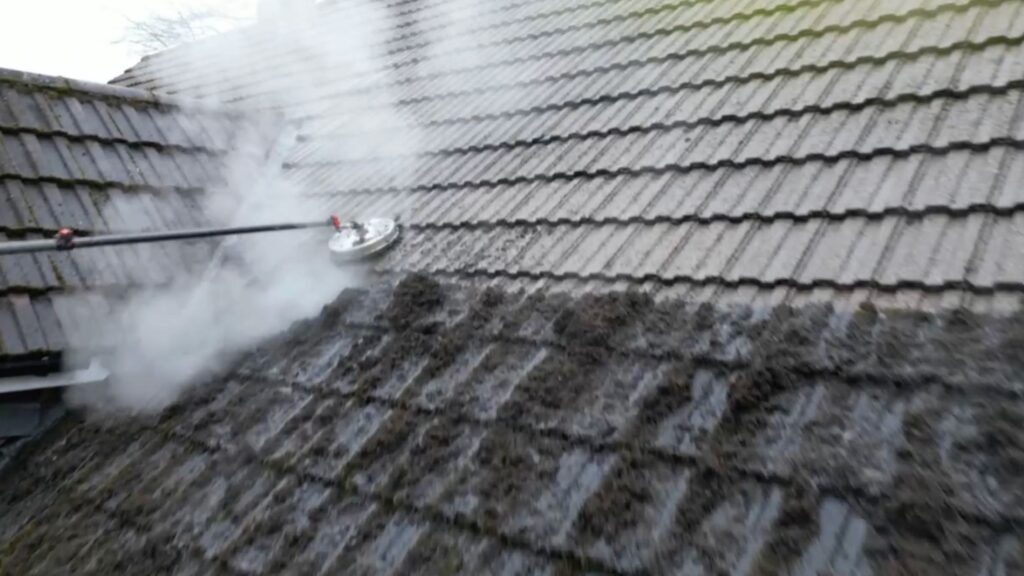Have you been looking up on your roof and wondering is it time to evict the furry green friends growing up there? Perhaps you’ve been walking around the edge of your house rushing to put the bins out in your slippers when you take a step and SQUIDGE, you’ve stepped in some moss that appears to have fallen from the sky! Either way, it sounds like you are thinking about getting rid of the moss that’s taken up residence on your roof. Our blog will help you understand Why does moss loves your roof? What damage it can cause? What are the best moss removal techniques? How can I prevent moss from growing back? Should I get a professional to do it for me? How much will it cost?

If you have thought about any of these questions then you have come to the right place…
Why Does Moss Love Your Roof?
What is moss? JJRoofing Supplies states this on their blog: “Moss is a small, non-vascular plant that thrives in damp, shaded environments. It reproduces through spores and can quickly spread across your roof, creating a thick, green carpet.” Read it here.
Yes, moss makes it home anywhere where it’s damp or moist, shaded or has access to regular moisture. Your roof is that ideal location; if it’s surrounded by nature, such as good tree cover, it’s likely the moss will build up further. As we all live in the beautifully sunny rainy country that is England, it’s highly likely your roof will start to get moss build up. Did you know? Roofs with north-facing slopes are more susceptible to moss growth!
Can Moss Damage Roofing?
Simple answer… Yes! Moss is a clever little plant that can absorb moisture and retain it. This process over a long period of time and across a large area like your roof can lead to damp issues, deterioration of your roof structure and so forth. If your roof is made of tiles (like most homes in the UK) moss can over time lift and dislodge tiles, which can lead to leaks in your roof and damage inside the property. It’s not just tile roofs, you might easily think I’ve got a flat roof or it’s covered in asphalt & shingles, so I am safe… right? Well, moss can break down the granules in both shingles and asphalt that protect the roof from UV rays, leading eventually to a broken roof and structural damage. So in short, moss, if left untreated on your roof WILL CAUSE DAMAGE. If you have read this far it’s likely you want to get rid of it, so what can you do? Let’s delve into the next section.
Roof Moss Removal Techniques
Removing moss from your roof is essential for maintaining its integrity and appearance. There are several techniques available, depending on the extent of moss growth and the roof type. If your roof is easy to access and you feel confident working at height here are some tips we’ve gleaned from our professional moss removal service…
Get the right tools… These Required Tools Include:
- Stiff-bristled brush on a LONG pole
- Garden hose (low-pressure setting)
- Roof safety harness
- Ladder with stabilizer
- Protective gloves
- Bucket to collect moss and muck
Get the Right Products…Materials Required:
- Biocide/moss killer
- Mild detergent (optional)
- Copper or zinc strips (for prevention on very small roof spaces only)
- Roof sealant (optional for flat roof surfaces)
- The Roofing Superstore had some great advice on chemicals which said: “An alternative to manually removing the moss with a brush and trowel is to use chemicals. There is a range of chemicals to use on your roof to kill any moss, and the benefit of using a chemical is that it will remove all of the smaller moss spores that you can’t necessarily see and any moss that is beneath the tiles.”
The process to remove moss with chemicals
Once you’ve got all your tools together, begin by scraping as much moss as you can from the roof manually. Once the moss is cleared, be sure to give your roof a rinse down with a hose on a low pressure setting (think make it rain not pressure wash your car, roofs are designed to withstand rain, not tidal waves). If applying a treatment of chemicals now is the time. Finally, dispose of your moss in the compost bin and apply any sealing roof treatments you’ve settled on for your type of roof.
The process to remove moss without a cleaning agent
The same as above but no need for chemicals! For minor moss growth, manual removal is a simple and eco-friendly solution. Use a stiff-bristled brush to gently scrub the moss from the tiles, working from the top of the roof downward to prevent tile damage. A garden hose with low pressure can help rinse away loose debris.
How Do the Pros Remove Moss on Roof?

At pristine clean we are professional moss removers, wether its on your driveway or up on the roof we have the tools and over 20 years of knowledge to make your surfaces clean and sparkle again! This is even more so for roofs. To make sure your roof surface is restored and moss free you need the right tools, chemicals and skills. We have them all, so how do we do it? Let’s see…
Manual Roof moss removal
This involves hand-scraping the moss from roof tiles using specialized tools. It’s labour-intensive but is a good option for very delicate old roofs. We have specialised tools which enable us to reach further than most. A professional roof cleaner will scrape the roof clear and help you dispose of the remains either with any composting arrangements you have or they will dispose of the cleared moss.
Soft wash roof cleaning
For roofs that need more elbow grease, professionals such as ourselves will use soft washing which is low-pressure warm water sometimes combined with a moss-killing solution. This method ensures thorough cleaning without the risk of damaging tiles, making it ideal for delicate roofing materials. The added eco-friendly chemicals don’t just remove the moss but restore the appearance of the roof too! It will definitely make your house stand out in the neighbourhood.

Cold Pressure/Jet Washing
Pressure washing is a quick way to remove moss but should be carried out cautiously. High-pressure jets can dislodge tiles, erode protective coatings, or force water under the roofing material, leading to leaks. This method is best suited for concrete or slate roofs where high pressure is less likely to cause damage. Our team is fully trained in all these methods and can advise you of the best process to bring your roof back to life and get rid of that pesky moss.
How long does Roof demossing take?
The time required for roof moss removal depends on the method used, roof size, and levels of moss. For a small home, you are looking at the following as a rough guide.
- Manual removal: 2–6 hours
- Soft wash treatment: 3–5 hours, with results improving over weeks
- Pressure washing: 1–3 hours, but requires careful application to avoid damage
If your tackling it yourself over a weekend, make sure it’s dry, boil the kettle and set aside the whole afternoon to clean the roof and then clean up afterwards.
How much does Roof demossing cost?
The cost of roof moss removal varies for each home, factors such as roof size, access difficulty, and the method used along with the desired result, moss removal or moss removal with roof restoration etc etc. Either way, the prices can vary greatly. That’s why we wrote a great blog all about this.. check it out here: How Much Does Roof Cleaning Cost?
For a precise estimate, consider getting a quote from Pristine Clean.
How to Prevent Roof Moss Growth
There are some great preventative measures that can help prevent moss from returning once the roof is cleaned. Some are good; others are limited in their usage. Here are a few…
Preventative measures can help reduce the chances of moss returning. These include:
- Trimming overhanging branches to allow more sunlight.
- Keeping gutters clean to prevent water buildup.
- Regular roof inspections and maintenance.
- Applying a professional biocide treatment to kill lingering moss spores and delay regrowth.
Can Zinc and copper strips help?
Copper and zinc strips are sometimes used to prevent moss, as rainwater reacts with the metal to create a moss-resistant surface. However, these strips are only effective within about a foot of where they are installed, meaning they won’t protect an entire roof effectively. Better treatments include the use of biocide.
What about chemical Treatments?
For long-term moss prevention, professional biocide treatments are recommended. At Pristine Clean, we apply a biocide solution after roof cleaning, ensuring that all organic growth is eliminated and preventing moss from returning prematurely. This treatment helps prevent moss buildup as it resets the roof back to scratch meaning for moss to grow it would have to start all over again. This treatment can help keep your roof looking clean and moss-free.
Moss on your roof is more than just an eyesore—it can lead to serious damage if left untreated. From manual removal to professional soft washing and biocide treatments, there are many ways to tackle roof moss effectively. While DIY methods can help, hiring professionals ensures a thorough, long-lasting clean while reducing the risk of damage to your roof.
If you’re ready to restore your roof and keep moss at bay, get in touch with Pristine Clean for a free, no-obligation quote today!
For more information on our services, visit: Roof Cleaning & Demossing

